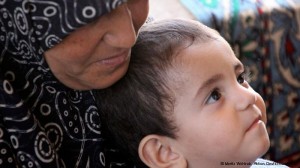 The number of Syrian refugees, mostly women and children, is climbing. Lebanese and international organizations provide help, but they are reaching the limits of their capacities.
The number of Syrian refugees, mostly women and children, is climbing. Lebanese and international organizations provide help, but they are reaching the limits of their capacities.
Every afternoon, the seven-year-old Ahmed comes to the Amel Foundation’s social center in Harat Hreik, a district of southern Beirut, where he learns Arabic, math, and English. The Amel Foundation is a Lebanese NGO that runs health and education centers across the country, offering help to Syrian refugees.
Ahmed, a rather shy boy, comes from Amuda, a town in the east of Syria. He had to leave the country a few months ago, and ended up in the Lebanese capital.
Ahmed spends the day in a Lebanese state school. In most classes, his abilities are lower than those of his Lebanese peers. Like many Syrian students, he is new to foreign languages. Around 30 Syrian children between four and 12 attend lessons in the Amel Foundation center, where classes are financed by the United Nations’ refugee agency, the UNHCR.
Iman Al-Khatib, an Amel Foundation social worker, said it took some time for refugees to appear at the center. “But now more and more children are coming,” she said. “They come from Beirut and the surrounding area.”
Fear of registration
Integrating Syrian children into the school system is just one of many challenges facing Lebanon. The number of Syrian refugees in the country has tripled since June. Most are camped in the north and east of the country, but an increasing number are making their way to Beirut and the south.
The UNHCR released the latest statistics at the start of November. Over 77,000 have registered at the UN refugee aid organization. On top of that, there are over 30,000 waiting for an appointment to register. Registered refugees get help finding health care, food, or extra money for the rent. But the real number of people fleeing the violence in neighboring Syria is anyone’s guess. Many are afraid to reveal their names at the registration points, while others aren’t even aware that the UNHCR even exists.
Umm Mundhir and her family do not appear in the statistics, for instance. A mother of seven, she fled the southern Syrian town of Daraa two months ago and moved in with her husband, who has been working in Lebanon for several years. The family of nine live in a two-room apartment in Beirut’s southwestern district of Sabra, one of the poorest and most densely populated areas of the Lebanese capital. The rents here are cheaper, and Umm Mundhir, a plump woman in her mid-30s, has never heard of the UNHCR. None of her children go to school, and though she is worried about their health, she cannot afford a doctor. She has not been able to leave Sabra since her arrival.
Collecting for a c-section
Nabila, a Palestinian social worker who did not want to reveal her real name, estimates that there are 220 Syrian refugee families in Sabra. “Every day we discover that more have arrived – sometimes 10 or 20 families a day,” she said. Nabila sometimes receives phone calls from newly-arrived families who need mattresses, or desperate women looking for help. Recently one Syrian woman needed a caesarean section, recalled Nabila, and young Syrians collected $1,000 (780 euros) to pay for the operation. “The representatives of the international organizations should come here and see how these people are doing,” said Nabila with a flash of anger.
In a report published in September, the UN aid agency uncovered huge problems in finding accommodation for the refugees in Lebanon. Private homes, disused schools and cheap living space were all exhausted. It suggested that extra empty buildings be rented out and rent benefits for private homes be increased. But that would require extra financing.
Living in unfinished buildings
The Amel Foundation’s director Kamel Mohanna also called for more effort. What Lebanese and international aid organizations had achieved so far was important, he agreed, but not enough. “Winter is just around the corner and the living conditions of the Syrian refugees is difficult,” he said.
Mohanna described how he found 64 people living in a half-built mosque in the small hamlet of Arsal in eastern Lebanon. “There were no sanitary facilities,” he said. “We managed to provide the necessities, with the help of an Austrian relief organization.” But he added that many private homes are also much too over-crowded. “It’s not like maybe three people live in one room – it’s more like 20 or 30,” he said.
And there are no signs that the crisis will abate any time soon – the UNHCR is expecting another 20,000 Syrian refugees to arrive in Lebanon by the end of the year.
DW
Leave a Reply
You must be logged in to post a comment.